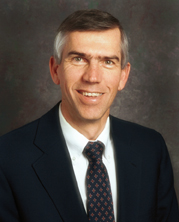3:15 p.m., May 22, 2003--A four-year study that analyzed videos of math teachers in seven countries concludes that American teachers need to do more to help students understand the concepts behind math, not just teach them the mechanics of problem-solving, according to James Hiebert, Robert J. Barkley Professor of Educational Development at UD.
 |
| James Hiebert, Robert J. Barkley Professor of Educational Development |
Hiebert, one of the principal investigators, has been involved in two video studies of math teaching for several years and used the first study as the basis of his book, “The Teaching Gap,” authored with Jim Stigler and published in the summer of 1999. That book put forth the idea that U.S. teaching methods, not individual teachers, have kept U.S. students from scoring well on tests that compare their achievement with those of their peers in other countries.
The most recent study looked at the U.S. and six countries that traditionally score higher on math achievement tests--Japan, Hong Kong, the Czech Republic, Switzerland, the Netherlands and Australia.
“A key question left unanswered by the previous study was whether all high-achieving countries teach mathematics like Japan,” Hiebert said. “Of the three countries in the previous study (Germany, Japan and the U.S.), only Japanese students perform at a consistently high level on international tests.
“Because Japanese math teaching looked strikingly different from that found in Germany and the U.S., it was natural to wonder whether their form of teaching is necessary for high student achievement. The results of this study showed clearly that the answer is, ‘No.’
“The teaching methods found in other high-achieving (Asian and European) countries differ substantially from Japan and from each other. In fact, the differences among the high-achieving countries, even on some features often considered important for students' learning, were quite surprising,” he said.
Hiebert was quick to stress that this doesn’t mean all teaching methods are equally effective or that teaching methods don’t matter. He says two kinds of results indicate there is something we can learn from studying the different methods used by teachers in high achieving countries.
“We found that the differences between mathematics teaching in the U.S. and in other countries were greater for countries that achieve much better than the U.S. than for countries that achieve only a little better. That is, the higher the achievement in a country, the more different from the U.S. are the teaching methods.
“There are a few features of teaching that the higher-achieving countries share, which are absent from U.S. teaching. We should pay particular attention to these,” he said.
In brief, Hiebert said, in most higher-achieving countries a majority of class time is spent dealing with new content—concepts and procedures that students have not seen before. The majority of time in a typical U.S. lesson is spent reviewing old material. Additionally, most higher–achieving countries spend some time during a typical lesson discussing the conceptual underpinnings of a topic (e.g., why a formula or procedure works to get a correct answer). Almost no time is spent this way in typical U.S. lessons. U.S. students spend most of their time just practicing procedures they have been taught, Hiebert explained.
“This last result is especially interesting in light of current questions about whether U.S. teachers have moved away from emphasizing skills and now spend too much time on other things, such as solving real-life problems. The results of this study show that, in typical eighth-grade math classrooms around the U.S., the vast majority of time still is spent practicing skills,” Hiebert said.
The U.S. needs a careful and thoughtful examination of the goals that are set for students in mathematics, Hiebert said, and an analysis of whether the teaching methods being used in typical classrooms give students a chance to achieve those goals. He also would like to see a better balance between practicing skills, discussing the conceptual underpinnings of the skills and solving challenging problems.
The most useful effect of the study would be for teachers to re-examine their own teaching using the results of the study as a mirror, Hiebert said.
“There are no tricks from this study that U.S. teachers could quickly learn. Rather, the kinds of changes suggested will require time for teachers to study, understand and then practice in their own classrooms. We usually underestimate how difficult it is to change methods of teaching,” he said.
A resource provided by the study is a set of videotapes of teaching in each of the seven countries involved. Four eighth-grade math lessons in each country are available, along with written commentaries by the teacher who taught the lesson and a researcher in the home country, the teacher's lesson plan and supplementary materials used during the lesson.
The videotapes are accessible online at [
www.lessonlab.com], the web site for the research institute that coordinated the study.
“These videotapes will allow U.S. teachers to see their own practices with fresh eyes and to see some alternative practices that they might not have thought of before,” Hiebert said.
A science component of the study, analyzing eighth-grade science lessons, will be released next year, Hiebert added.
Article by Beth Thomas
Photo by Jack Buxbaum

